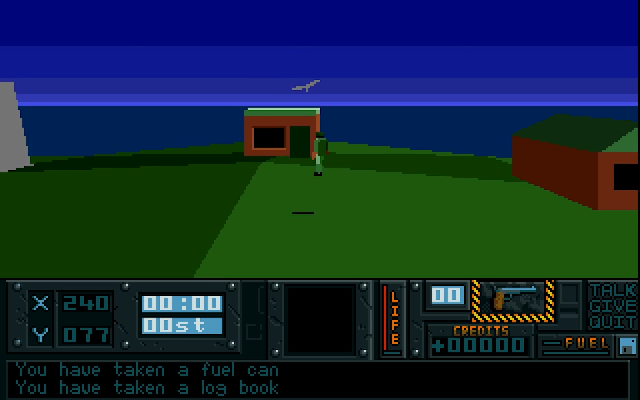Hunter
 |
Hunter – Open-World Warfare Before It Was Cool
Released in 1991 for the Amiga and later the Atari ST, Hunter by Activision was a groundbreaking game that introduced elements of 3D open-world gameplay years before it became an industry norm. Developed by Paul Holmes, the game combined military simulation, exploration, vehicular action, and mission-based structure into a polygonal 3D world—unprecedented at the time.
 |
 |
 |
 |
Gameplay: Do Anything, Go Anywhere
Players are dropped into a vast terrain filled with enemy soldiers, buildings, vehicles, and natural obstacles. You take on various missions—rescue, espionage, assassination—using a wide range of drivable and pilotable vehicles, including jeeps, tanks, helicopters, and boats. You can even ride bicycles or steal enemy rides, adding to the game's sandbox appeal.
What stood out was the freedom of approach: you could charge in, go stealth, or even swim across vast seas if needed. The controls were basic but responsive for their time, and the world felt dynamic in a way that no other game in 1991 could match.
 |
 |
 |
Vehicles You Can Drive in Hunter
One of the standout features of Hunter (1991, Amiga/Atari ST) is the variety of vehicles you can commandeer—including land, sea, and air units. Each has unique handling and tactical advantages.
- Car / Van / Jeep – Fast overland travel with no weapons or armor.
- Tank (Sheridan & Angus types) – Heavy armored vehicles with 80 mm guns; powerful but slower.
- Ambulance – Slower and more visible, but allows access to hospitals.
- Boat / Rocket Boat – Perfect for sea travel; rocket boats are fast but vulnerable to torpedoes.
- Hovercraft – Crosses both land and water, ideal for versatile navigation.
- Bicycle – A Slow but silent alternative for tight land areas.
- Windsurfer – Sail-powered—no fuel needed, but winds dependent.
- Rowboat – Basic river craft; slow but useful when no motorboats are available.
- Helicopter – Fastest way across islands, but requires fuel and careful landing.
- Enemy Vehicles – You can hijack enemy jeeps, boats, or tanks if unoccupied, adding a layer of strategy.
Fuel management is crucial—each motorized vehicle needs jerrycans to avoid being stranded. The mix of transport methods combined with weaponized vehicles gave *Hunter* a surprising sandbox feel that foreshadowed later open‑world classics.
 |
Game Modes in Hunter
Hunter offers three distinct gameplay modes, each providing a unique experience:
- Hunter Mode: Embark on a mission to locate and eliminate the enemy general. This mode emphasizes exploration and interaction, requiring players to gather clues from civilians, bribe enemies, and utilize various vehicles and weapons to achieve their objective within a set timeframe.
- Missions Mode: Engage in a series of short, time-limited missions that increase in difficulty. Each mission presents a specific objective, such as destroying enemy structures, and must be completed before proceeding to the next.
- Action Mode: Take on a large-scale mission where multiple enemy targets are designated from the start. Players have the freedom to choose the order in which to eliminate these targets, allowing for strategic planning and execution.
Each mode offers a different approach to gameplay, catering to various playstyles and providing extensive replayability.
 |
 |
Graphics and Sound
Hunter featured flat-shaded 3D polygons with no textures—primitive by today’s standards, but incredibly impressive for early '90s hardware. The game’s day/night cycle and weather effects gave it a unique, immersive quality. Sound was minimal but functional: ambient effects and vehicle noises helped sell the illusion of a living world. Notably, the game employed a fixed isometric camera angle, providing a consistent viewpoint throughout gameplay. While this perspective enhanced the game's immersive experience, it also meant that players could not rotate the camera to view the environment from different angles, which could make navigation and situational awareness more challenging.
 |
 |
 |
Legacy
Although Hunter didn’t become a household name, it quietly influenced the sandbox genre years before titles like GTA or Operation Flashpoint appeared. It’s now considered a cult classic and a technical achievement on limited hardware. For those who owned an Amiga, Hunter was a glimpse into the future of game design.
 |
 |
Platforms and Releases
Hunter was first released in 1991 for the Commodore Amiga, followed shortly by a port for the Atari ST. Both versions were nearly identical in gameplay and visuals, although the Amiga version had slightly better sound and smoother performance.
Despite critical praise, no console ports or sequels were officially developed, and the game remained an Amiga/ST exclusive throughout its commercial life. It has since become a cult classic and is often played today via emulation.
 |
 |
 |
Verdict
 |
Hunter is a visionary title that punched far above its weight. It gave players a freedom that was almost unheard of in 1991, and its blend of strategy, action, and open-world design makes it a must-play for retro gaming enthusiasts.
Pros
✔ Revolutionary open-world freedom for its time.
✔ Wide range of vehicles and tools.
✔ Dynamic environments with time and weather effects.
✔ Non-linear mission structure.
Cons
✘ Primitive polygonal graphics.
✘ Some controls and camera angles can be clunky.
✘ Lacks detailed sound or music.
Final Score (Amiga)
90%




Comments
Post a Comment